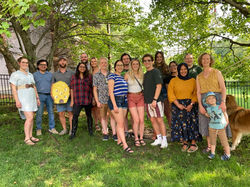top of page
shade lab
understanding microbiome resilience
Welcome to the website of Ashley Shade's research program at Université Claude Bernard Lyon 1 with the Laboratoire Ecologie Microbienne!
#ShadeLab #resilience
Microbial communities (also called microbiomes) are composed of up to tens of thousands of different types of microbial members, including bacteria, fungi, viruses, and tiny eukaryotes. These communities perform essential functions for their ecosystems. In our research, we want to understand how environmental microbiomes respond to the changing climate. The capacity to recover quickly and fully from a large stress is called resilience, and our research aims to determine the mechanisms that support resilient systems.
We want to understand:
-
the relationship between microbial diversity and resilience;
-
the microbial traits and mechanisms that promote resilient communities;
-
how to predict a shift in microbiome performance, and how and when to intervene to prevent it
-
functional redundancy - when more than one microbial population can perform identically- and its importance for stable microbiome performance; and
-
how interactions among different microbes influence resilience.
We know that microbiomes are generally sensitive to changes in their environment and to stress. Excitingly, many microbiomes have an immense capacity for resilience. Therefore, we hypothesize that there are ecological rules of microbiome resilience that can be usefully applied across different environments. Our research is grounded in ecological framework and focused on building transferable theory, approaches, and knowledge of mechanisms that transcend any particular microbiome host or ecosystems. We aspire that this work will broadly advance fundamental and predictive microbiome science.
We have worked in many environments to understand the general aspects of microbiome resilience. We currently study environmental microbiomes from: soils, plants and synthetic communities that we create in the lab. We have also used data mining and meta-analyses to investigate broad patterns of microbial diversity across many environments.
keywords: microbial ecology and evolution, soil microbiome, plant microbiome, plant resilience, disturbance ecology, rarity, dormancy, temporal dynamics, environmental microbiology, microbial diversity, macroecology, metagenomics, metabolomics, synthetic communities
Affiliations
Laboratoire Ecologie Microbienne UMR 5557, Université Claude Bernard Lyon 1
CNRS - Institute of Ecology and the Environment
bottom of page
















